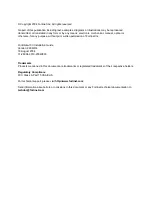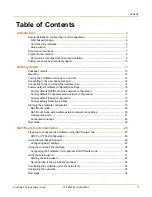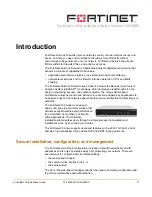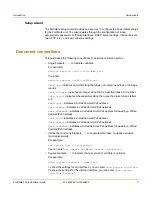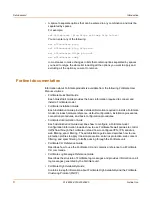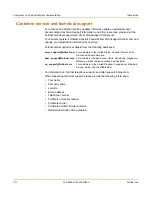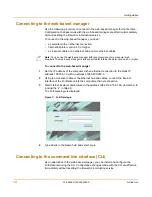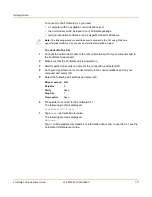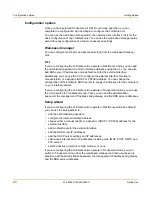
Introduction
Setup wizard
FortiGate-100 Installation Guide
01-28004-0019-20040830
7
Setup wizard
The FortiGate setup wizard provides an easy way to configure the basic initial settings
for the FortiGate unit. The wizard walks through the configuration of a new
administrator password, FortiGate interfaces, DHCP server settings, internal servers
(web, FTP, etc.), and basic antivirus settings.
Document conventions
This guide uses the following conventions to describe command syntax.
• Angle brackets
< >
to indicate variables.
For example:
execute restore config <filename_str>
You enter:
execute restore config myfile.bak
<xxx_str>
indicates an ASCII string that does not contain new-lines or carriage
returns.
<xxx_integer>
indicates an integer string that is a decimal (base 10) number.
<xxx_octet>
indicates a hexadecimal string that uses the digits 0-9 and letters
A-F.
<xxx_ipv4>
indicates a dotted decimal IPv4 address.
<xxx_v4mask>
indicates a dotted decimal IPv4 netmask.
<xxx_ipv4mask>
indicates a dotted decimal IPv4 address followed by a dotted
decimal IPv4 netmask.
<xxx_ipv6>
indicates a dotted decimal IPv6 address.
<xxx_v6mask>
indicates a dotted decimal IPv6 netmask.
<xxx_ipv6mask>
indicates a dotted decimal IPv6 address followed by a dotted
decimal IPv6 netmask.
• Vertical bar and curly brackets
{|}
to separate alternative, mutually exclusive
required keywords.
For example:
set opmode {nat | transparent}
You can enter
set opmode nat
or
set opmode transparent
.
• Square brackets
[ ]
to indicate that a keyword or variable is optional.
For example:
show system interface [<name_str>]
To show the settings for all interfaces, you can enter
show system interface
.
To show the settings for the internal interface, you can enter
show system
interface internal
.


